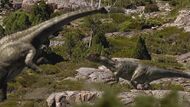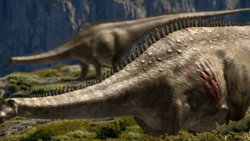
152, 000, 000 BCE - Late Jurassic - Colorado
This Diplodocus centred storyline, was scientifically advised by the renowned expert on Sauropod Dinosaurs, Kent Stevens of the Oregon University, USA.
His greatest contribution, was spearheading what was then the growing trend amongst British and American Palaeontologists, that they should reposition the 'classic swan-necked' view of Sauropods, into an elongated horizontal form; with the Diplodocus unable to raise their necks above a certain low level not much higher than their own pelvis. However, this was later proven to be incorrect, with further Palaeontological research into their biomechanics.
He also helped other episodes and the juvenile Diplodocus scene in this episode, with both puppeteer and Palaeontologist as well as Tim Haines the Director, actively furthering the science by doing practical experiments with the life like model head and neck. Kent Stevens himself remarked of how impressed he was by this.
Diplodocus Palaeobiology was yet again refined, thanks in no small part to the Walking With Dinosaurs Series. The Late Jurassic setting is tantalisingly over 68 Million Years after the previous Late Triassic episode - by far the largest jump in time in between episodes.
This episode was shot in the most amount of locations: California, Chile, New Zealand, and Tasmania.
Plot[]
This is the second episode of the series. This episode followed the life of a young female Diplodocus. After hatching at the forest edge, she and her siblings retreat to the safety of the denser trees.
As they grow, they face many dangers, including predation by Ornitholestes and Allosaurus, and a Stegosaurus, which accidentally kills one while swinging its tail. Another one is killed soon after by an Allosaurus

The confrontation between the female Diplodocus and the bull Allosaurus
Close to adulthood, the group of young Diplodocus are nearly all killed by a huge forest fire and fire storm that night, leaving three, then two survivors including the main female. They are driven out onto the open plains, where they find a herd.

Wounded diplodocus after the fight
The protagonist female mates, but not long afterwards is attacked by a bull Allosaurus. She is saved when the older female Diplodocus hits the predator with its whip-like tale. The Allosaurus leaves deep wounds on her side, but, as Kenneth Branagh said, these will heal in time.
It is also noted that in time she shall become too great in size to be threatened by any existing land predator, reaching a grand old age exceeding 100 years (some Palaeontologists have theorized that they could have been much older somehow, like Giant Tortoises are, having lifespans exceeding 250-300 years. This would be interesting if proven correct.
Dinosaurs[]
Pterosaurs[]
Filming Locations[]
The majority of the episode was shot in California National and State Parks, while other filming locations in Chile, New Zealand, and Tasmania.
- Most of the scenes with the Diplodocus hatchlings slowly maturing into adults, plus the scene where the adult Diplodocus topple the trees, were shot in Redwood National and State Parks; a few more scenes were shot in Te Urewera National Park, New Zealand.
- The aerial shots of the forest were shot at Shortleaf Black Spruce Forests in California.
- The prairie scenes were shot at the Conguillio National Park in Chile.
- The confrontation with the Stegosaurus and Allosaurus was shot at Fern Canyon in Prairie Creek, Redwoods State Park, Orick, California.
- The final scenes were shot at the Walls of Mount Jerusalem National Park in the Central Highlands of Tasmania.
Trivia[]
- This episode contains the least non-dinosaur creatures of all the episodes.
- This episode was shot in 4 locations, the highest number of locations in the series.
- One of the hardest to create and longest to finalise animation shots in the series, took place in this episode. This is the panning shot in which we see Stegosaurus, unidentified Hypsilophodontids, (as yet) unidentified Anurognathus and then the main feature, a mighty herd of Diplodocus walking into the camera position as a column. The Sauropods took 75,000 times longer to create, than it took to view them on screen.
- The model for Othnielia was the same one used in Death of a Dynasty for Parksosaurus and would not be identified as Othnielia until it was reused during The Ballad of Big Al.
- The appearance of Anurognathus in this episode is incorrect as they actually lived in Europe.
- Sadly, despite being a good theory, Kent Stevens theory about the neck posture of sauropod dinosaurs is know known to be completely incorrect following studies conducted by Michael Taylor and Mathew Wedel.